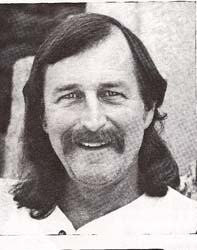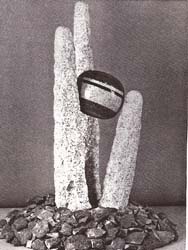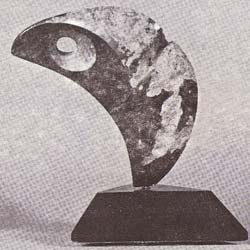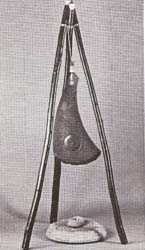This is an interview with sculptor Michael Jacobsen at his home and studio in Bellingham. WA, where he lives with his wife Carol and daughter Britt. Michael is a current NWSSA board member and chairs the exhibition committee. He has been working full time on his sculpture for the last year and a half after having left a career as a museum exhibih"on designer. He has previously been a print shop layout artist, skippered a sailboat, been a ranch hand, ron his own sign business, and managed a university art gallery. He hold a BFA degree in sculpture. He is a kind, thoughtful person with a deep sense of spirit and connection to the Earth. He is also a prolific sculptor. We start by viewing his portfolio.
MJ: (Looking at his "Norse Sea Rising" of black Belgian marble approximately 42"h x 19"w x 8"d). This piece started out as a representational dorsal fin of a killer whale. As it progressed, it evoked the shape of a Viking ship prow so it merged in between the two. In the same fashion that the prow of a ship cuts through the waves, a killer whale cuts through the waves. This created the idea of the symbolized wave or curl. To me it has more symbolism than that. I'm also exploring the Celtic and Viking imagery. With the Celts, there are lots of curvilinear elements.

SS: Did you start with a conscious desire to explore that theme?
MJ: The desire started with wanting to do a killer whale fin. This gets into an explanation/exploration of what I call .. Earth-hased roots." I saw an exhibition of Native American work in which the artist, Marvin Oliver, did a beautiful, stylized sculpture of a killer whale. It had all the native symbolism on it, with strong curvilinear design elements. I was struck by the power of that singular image of the vertical killer whale fin. I suspect, to the seafanng people, It must have been a near mystical image.
I used to feel cut off from being able to do that kind of imagery. If you do a killer whale dorsal fin, it's difficult for that not to look Pacific Northwest Native American. We have to go a little bit further back in history than Native American to find our roots. but my Earth-based indigenous roots are in Northern Europe. All of the Earth-based imagery I could ever want is alive and well there.
SS: Is this your major drive, your major theme in your art?
MJ: The connection between my pursuit of spirituality and my pursuit of art is paraJIel. They're inseparable. It's hard to taJk about art without flipping into a spiritual conversation.
SS: Is your art a natural outflow of your state of being and belief? Or is it a more conscious process in which you choose to express something?
MJ: You're asking BIG questions (laughter). So why do I do art? I relate that to the day-to-day basis of "what do I most want to do today?". What I most want to do today is to make art. And out of that comes a pursuit of a meaning for life. In a word, the important thing for me is relationship; the striking of a relationship between the material and me. Many of ns taJk about various stones and their qualities. In the Association, there are many who seem to have a love affair with stone.
Most of us who do direct carving work at various levels to pursue that direct relationship. In the same way you read a book, you read a stone. Sometimes it has dominant themes. That leads you in a direction. If you follow that direction and you make a move or a cut on the stone, that , changes the landscape, the relationship. Then you make another move and so on, there's a continual dialogue. (Michael quotes a William Michael Jacobsen IStafford poem.) ... each rock says 'your move,' then waits until you do ... You make a cut then it's your move again. So you're continually having this relationship with the stone until you feel the sculpture is completed.
SS: Is most of your work direct carving?
MJ: Yes. I have never made a model with the intent to go find a stone and make the piece fit the model. If I've ever made a model, it's only to help me clarifY confusion about what I'm seeing in the stone during the process.

SS: How do you develop a relationship with a stone that doesn't have a predominate shape?
MJ: If you bring me a cube of stone, I don't know what to do with it. My preference is to be attracted to a stone initially. I don't have to worry about it then. In the world there are so many attractive stones.
If you bring me a cube of stone, I don't know what to do with it. My preference is to be attracted to a stone initially. I don't have to worry about it then. In the world there are so many attractive stones.
SS: Does that process work in the realm of cominissioned work?
MJ: I think it can, depending on how much freedom you're given in the process of the commission. The client has to realize that there might be changes to the original idea along the way. A time comes to mind when the commission became a piece unrelated to the model. That was acceptable to the client. That process allowed for a better piece to emerge. It gives the flexibility that's needed when working directly with the material to alter and move in the direction that the stone might lead you.
SS: (We visit his current show, "Elemental Earth," at the Blue Horse Gallery in Bellingham, W A.)
MJ: This show contains a series of pieces entitled "Stones of the SkY" after a book of poems by Pablo Neruda. Written at the end of his life, he was writing love poems to the Earth. The things he realized he was leaving behind and simultaneously going towards were stones. The depth of his relationship with the mineral world was amazing.
SS: With character stones like these, do you try to consider a more involved composition?
MJ: I generally try to create very strong shapes. In this case, the stones didn't allow me to do that. So this is an attempt to collaborate with the material. If you're truly collaborating with the stone, it's a dance between the two, the stone and yourself. Sometimes there's a battle of wills between what the stone wants to do and what you want to do. These stones were very powerful teachers for me in the sense of making sure my collaboration was minimal. These stones did not want to be cut radically. "The Philosopher and Students" has another dimension to it. I was taught quite a lesson with these stones. I found them on a beach at low tide and hurt my back very badly while loading them into my canoe. Among other things, they taught me how to ask for help.
The "Sentinel" sculpture is named after a place (in the Cascades) whcrc I go on my annual, solo, wilderness "spirit quest." There is a pinnacle of rock in a canyon that is a 'er, imponant place for me. This sculpture is an honoring of thai place. (We look at "The Philosopher and Studcnts." a five-stone grouping set in a bed of small stoncs) I found these stones four years ago and I've been looking at them for that long and placing them in many interrelationships. I ended up doing the most minimal amount. This large stone seemed to be a dominant stone and had the look of a monk with a cowl. I couldn't find myseIf making a major cut on any of these stones. So I made facets or "faces" in the natural stones.
SS: Is your experience of doing fully formed sculpture and minimally formed natural stone dramatically different?
MJ: They have their roots in the same process. "Jupiter Rising" (a fully sculpted form) was made through a series of decisions and moves that led from one step to the next along the path to the finished piece. The "Philosopher and Students" was saying "I'm just fine, thanks; you don't need to do anything here."
Thcre is already a huge audience out there who is as interested in stone as we are. When something is obviously about "stoneness,"-the qualities of stone-then that can become a focus. The artist opens a door or access point to the art. Sometimes it is a representational form. Sometimes the beauty of the stone itself is the open door that will draw in the viewer. Sometimes the open door is a sensual shape. Sometimes it might be a polished surface that attracts their eye and they reach out to touch the stone. There are many ways that artists have to create "open doors" for the viewer.
My intention is to communicate with the viewer. I want to find those access points that open doors which allow a viewer to come into a relationship with the work I do. I consciously attempt to allow those access points. Then I have to release it, let it go. Quite often I'm surprised how a piece I do, that has a certain intention, matches up with a person who is receptive to the same intentioll. There is magic that happens in that process. (He tells of a sculpture, "Tree of Life," which synchronously was chosen to honor a man who was responsible for acquisition of forestland for county parks. It is installed at Big Rock Gardens, Bellingham, WA.
Another experience of synchronicity was with "Phoenix Rising." I originally saw a bird shape in the stone (portoro marble), but was frustrated by all the color in the stone. I awoke one morning realizing that the bird could be the Phoenix and that the color could be the flames, with the bird coming up out of the fire. At the same time, due to job stress, my doctor said I should get away from the work place. While on medical leave, I went to the stone and started developing this idea. In the process of working on the shape of the Phoenix, I was also, in a parallel way, working on my own internal Phoenix that was rising. It was so powerful it brought tears to my eyes. This is the fine tuning of the creative life; being able to create your life in the process of exploring your creative ideas. That process led me to doing art full time and I never went back to my previous job. That magicaJ relationship with stones happens infrequently, but it happens enough to make me want to continue.
SS: (We view his jade "Paleolithic Ceremonial Adze. ") I want to explore the idea of the ancient hand tools more. Jade was used frequently because of its resiliency and strength. There's a granite piece at Gallery Mack in SeattJe entitled "Neolithic Altar," paying respects to a hand adze in a large scale. The desire is to recapture some of that initial connectedness that the Paleolithic or Neolithic humans had with stone.
(We look at "First Sacrament" in which a basalt form in the shape of an adze hangs from a wood tripod over a ceremonial stone altar.)
SS: What is your preferred working process?
MJ: If I had my druthers, I'd have thirty pieces going at any given time. If I get disappointed or discouraged with thc piece I'm working on, I just take a break, walk around, and work on pieces I'd previously started. Or I might start an entirely new piece. I eventually get back to the pieces I'd worked on before and finish them up.
A gem of wisdom that JoAnne Duby gave us at the '98 symposium was to consider the base as an integral part of a piece early on in tile process. With each piece (in his current show) the base becomes a connector with the Earth because the stone came from the Earth. I've taken them from the Earth and set them in a pristine gaJlery setting. I want the base to relay a sense of its connection with the Earth. My preference would be to have sculptures that are outdoors and are literally connected with the Earth.
SS: What scale do you prefer to work in?
MJ: If you have something you can pick up and put into your hand, that piece comes into your space: there's an intimacy there. The same thing with larger scale works. They can fill your peripheral vision: thcy become present with you in your own space. In a different way, they have an intimacy about them as well. The mid-sized pieces that sit on a pedestal and are too heavy to pick up, create a kind of a distance. To me they lack that intimacy. So I like the small and the large-scale pieces best.

SS: What is your involvement in NWSSA?
MJ: I've been on the Board of Directors less than a year and we've been working mostly on our organizational structure. We're in transition, becoming a more professional organization, refining goals and objcclives. Our challenge is to continue to incrcasc the support and opportunity for the advanced and professional artist, while maintaining our supportive environment for beginners.
SS: Many thanks, Michael.
